How to Choose the Right Rope Access Equipment

Rope access work demands not only skill and training but also the use of specialized equipment that ensures safety, efficiency, and reliability. The selection of the right gear is crucial for both the protection of technicians and the successful completion of tasks. In this article, we will break down the essential pieces of rope access equipment, discuss their importance, and offer tips on how to choose the best gear for your needs.
Why Choosing the Right Equipment is Critical
Rope access work often involves high-risk environments such as tall structures, confined spaces, and hazardous industrial settings. Selecting the appropriate equipment ensures that technicians can perform their jobs safely, efficiently, and without unnecessary delays. Faulty or inappropriate gear can lead to accidents, project delays, and higher costs.
When choosing rope access equipment, consider the following factors:
- Safety Standards: Ensure all equipment meets industry standards such as those set by organizations like SPRAT, IRATA, and OSHA.
- Job Requirements: Different tasks may require specific tools and gear, so understanding the scope of your work is essential.
- Quality and Durability: High-quality, durable equipment may cost more but will last longer and provide greater safety.
- Comfort and Fit: Technicians often work for long hours, so equipment that fits well and is comfortable will reduce fatigue and increase productivity.
Essential Rope Access Equipment and How to Choose It
1. Harnesses
The harness is the most important piece of gear in rope access. It provides support and secures the worker to the rope system, allowing for safe positioning while working at heights.
- Choosing the Right Harness: Look for harnesses designed specifically for rope access rather than general climbing harnesses. A full-body harness is typically required, offering maximum support and comfort. Ensure that the harness has certified attachment points for both fall arrest and work positioning, and consider features such as padded leg loops and shoulder straps for added comfort during long hours of use.
Example: The PETZL AVAO® BOD harness is a popular choice among rope access technicians due to its ergonomic design, adjustable leg loops, and integrated fall arrest system.

2. Ropes
Ropes are the lifeline of any rope access operation, and choosing the right type is critical for both safety and performance.
- Types of Ropes: Static ropes, which have low stretch, are typically used in rope access because they provide more stability when ascending or descending. Dynamic ropes, which stretch more, are used less frequently, primarily in rescue scenarios or climbing-related work.
- Choosing the Right Rope: Select ropes that meet the safety standards set by EN 1891 or ANSI Z359. The diameter of the rope should be suitable for the weight of the technician and the nature of the job—usually between 10mm and 12mm. Ensure the rope has a high tensile strength and is resistant to abrasion and UV exposure.
Example: The BEAL® 11mm Apollo static rope is widely used in the industry for its strength, durability, and resistance to abrasion.
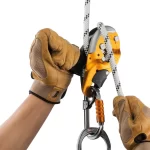
3. Descenders
Descenders allow technicians to control their descent along the rope. These devices regulate speed and provide a safe means of moving downward.
- Choosing the Right Descender: Look for descenders with self-braking mechanisms, which are designed to stop descent automatically if the technician loses control. Consider lightweight and compact models for ease of use, but ensure they are compatible with the rope diameter you are using.
Example: The PETZL RIG® is a self-braking descender often used in rope access for its easy-to-use handle, compact design, and precise control over descent.
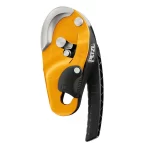
4. Ascenders
Ascenders are used to climb ropes and are essential when technicians need to ascend to higher work positions.
- Choosing the Right Ascender: Ascenders should offer a firm grip and be compatible with the rope diameter being used. Look for models with a safety catch to prevent accidental disengagement from the rope. Some ascenders come with additional features, such as integrated pulleys for more efficient hauling.
Example: The PETZL ASCENSION® handled ascender is a favorite in the rope access community for its ergonomic handle, durability, and secure grip on ropes.
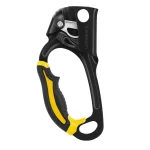
5. Carabiners
Carabiners are used to connect various components of the rope access system, such as ropes, harnesses, and other equipment. They are critical for securing technicians and gear during operations.
- Choosing the Right Carabiner: Look for carabiners made from durable materials like aluminum or steel. Locking carabiners, especially those with auto-lock mechanisms, are preferred for added security. Make sure the carabiner’s gate and locking system are easy to operate, even with gloves on.
Example: The PETZL OK® screw-lock carabiner is highly rated for its versatility, lightweight design, and reliable locking mechanism.
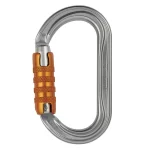
6. Lanyards and Fall Arrest Systems
Lanyards are used for positioning and as part of fall arrest systems to prevent technicians from falling while working.
- Choosing the Right Lanyard: Look for adjustable lanyards that allow for easy positioning and include shock absorbers to minimize the impact of a fall. Ensure the lanyard meets fall protection standards and is the correct length for the job.
Example: The PETZL ABSORBICA® energy-absorbing lanyard is designed to limit fall impact and is often used in rope access for fall protection.
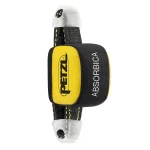
7. Helmets
Helmets protect technicians from head injuries caused by falling objects or impacts during rope access work.
- Choosing the Right Helmet: Helmets designed for rope access should meet EN 12492 or ANSI Z89.1 standards. Look for helmets with chin straps to prevent them from slipping off during a fall. Additional features like integrated visors, ventilation, and compatibility with hearing protection can also be beneficial.
Example: The PETZL VERTEX® VENT helmet offers excellent protection with a comfortable fit, ventilation, and attachment points for headlamps and visors.
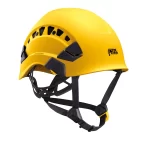
8. Gloves
Gloves provide hand protection from rope burns, cuts, and abrasions during rope handling and other tasks.
- Choosing the Right Gloves: Look for gloves made from durable materials such as leather or reinforced synthetic fabrics. Ensure they offer a good balance of dexterity and protection. Some gloves are specifically designed for rope access work and feature reinforced palms and fingers for better rope handling.
Example: The PETZL CORDEX® gloves are known for their durability, flexibility, and protection during rope access tasks.
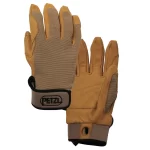
Final Considerations
When choosing rope access equipment, always prioritize safety and durability over cost. The equipment must be certified to meet industry standards and should be regularly inspected and maintained to ensure continued safety. Additionally, equipment that fits well and offers comfort is essential for technicians who spend long hours working in difficult positions.
Key Tips for Selecting Rope Access Equipment:
- Always check for certification from recognized safety organizations.
- Invest in high-quality, durable gear that can withstand frequent use and harsh conditions.
- Ensure equipment is compatible with the tasks you’re performing (e.g., rope diameter and descender type).
- Regularly inspect and maintain your gear to prevent wear and tear from compromising safety.
Relevant links
- SPRAT (Society of Professional Rope Access Technicians) – Safety Standards
- IRATA (Industrial Rope Access Trade Association) – Equipment Guidelines
- PETZL Rope Access Equipment
- OSHA (Occupational Safety and Health Administration) – Fall Protection Standards
- Rope Access Equipment Care and Maintenance
By carefully selecting and maintaining the right equipment, rope access technicians can ensure safe, efficient, and productive operations, even in the most challenging environments.

